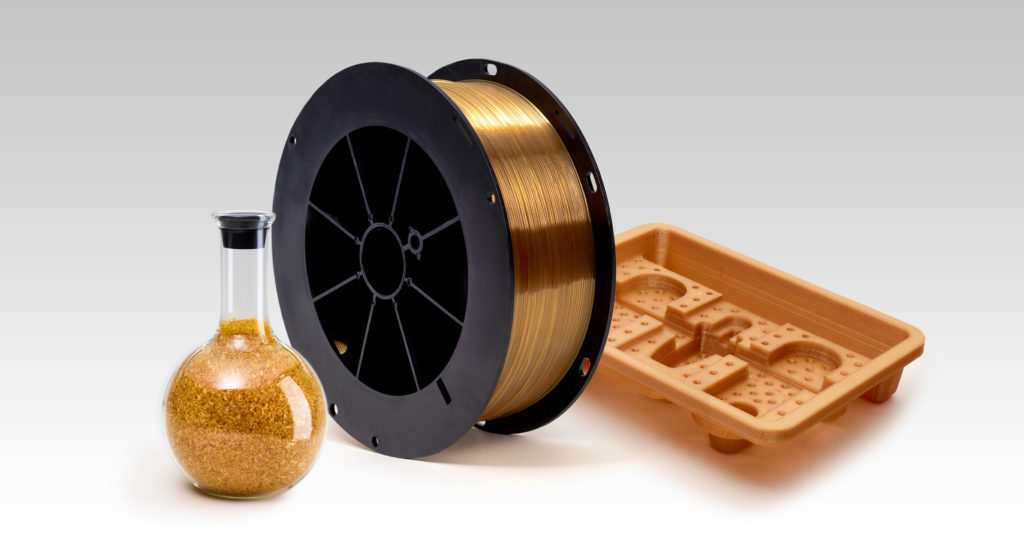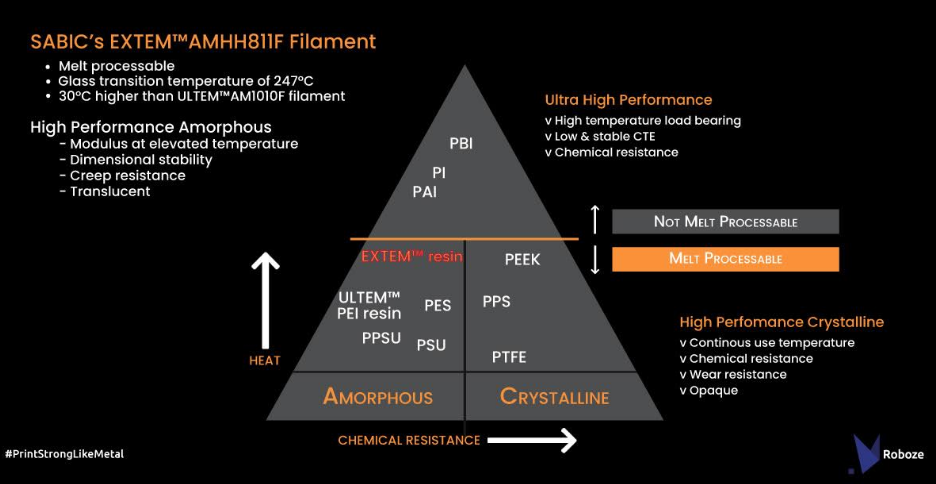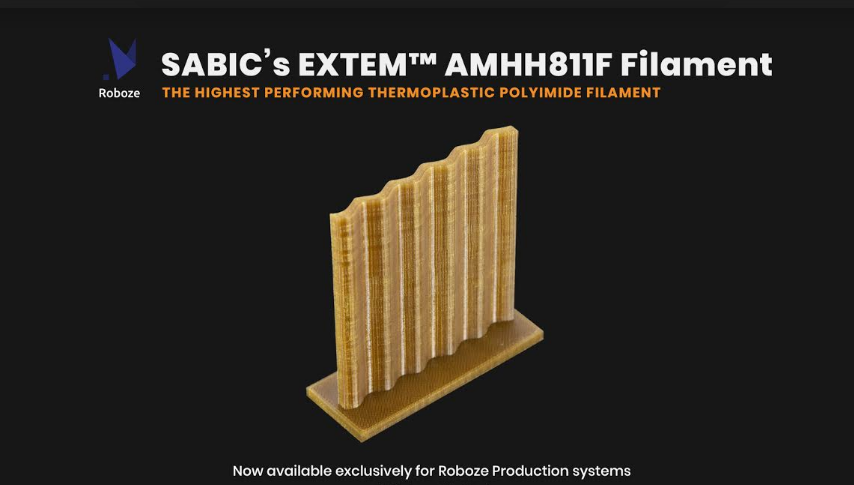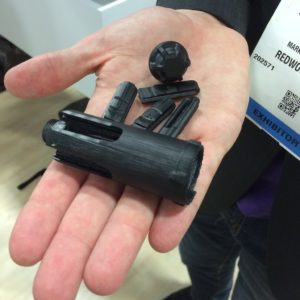Leonardo makes time and cost savings by utilizing ROBOZE FFF 3D printing technology
Climate Disrupted: Oil Companies Bet on Plastic in the Face of Climate Crisis
Given the global shift to renewable energy, fossil fuel companies are looking for new ways to maintain their livelihoods. In a 2018 investor report, ExxonMobil admitted to a decline in demand for gas and aims to replace those profits with petrochemicals, expecting a 30 percent increase in demand by 2025.
The International Energy Agency (IEA) believes that, by 2050, half of growth in oil demand will come from petrochemicals, replacing auto transportation demand. In the IEA’s Sustainable Development Scenario from its 2017 World Energy Outlook, oil consumption for transportation is reduced by almost 15 million barrels per day (Mbd) from 2016 to 2014, while oil use for petrochemicals actually increases by 4.2 Mbd.
Given the expected increase in demand for petrochemicals in the near future, the 3D printing industry should be ideally positioned to take advantage. According to SmarTech’s most recent report, “Polymer Additive Manufacturing Markets and Applications: 2020-2029”, polymer 3D printing is expected to “generate $11.7 billion in revenues in 2020, grow to $24 billion in 2024 and as much as $55 billion yearly by the end of this decade.”
In the past several years, we’ve already seen a number of chemical companies enter the AM market. Perhaps most notably is BASF, the largest chemical company that has invested in such 3D printing firms as Materialise and Essentium, developed numerous AM materials, and acquired 3D printing service bureau Sculpteo outright. Outside of manufacturing plastics, BASF is involved in agrochemicals and oil and gas exploration and production.
With the world’s second-largest crude oil reserves and second-largest daily oil production, Saudi Aramco is another leading player. The state oil and gas company owns 70 percent of SABIC, the fourth-largest chemical company and manufacturer the popular ULTEM brand of polyetherimide (PEI), as well as other materials for 3D printing. Specific varieties of ULTEM are certified to meet aerospace regulations and are widely used in these applications. For 3D printing, the material was previously only available for use with Stratasys extrusion systems, but SABIC has since found new partners to use its high-strength, high-temperature resistance materials.
Other chemical multinationals currently in the AM market include Lubrizol, Dow Chemical/DuPont, Evonik, Henkel, DSM, Mitsubishi, Clariant, Huntsman, Eastman, DuPont, Victrex, Lehvoss, Owens Corning, Covestro and Arkema. All of these companies are directly involved in the production of plastics from fossil fuel sources and a number of them have been or are directly involved in fossil fuel exploration and/or production.
The fact that some of those that were directly involved in fossil fuel production and have sold off or shut down those divisions could be indicative of the shift taking place. Lubrizol, for instance, eliminated Lubrizol Oilfield Operations in 2017. Evonik sold off its coal-based energy business in 2014.
One factor to consider in anticipating the future of plastic is the fact that an increasing number of governments are initiating or discussing plans for phasing out the use of single-use plastics, which represent a large portion of the materials polluting our oceans and the bodies of life on earth.
In an investor article titled “Oil’s future paved with plastic,” Bank of America Merrill Lynch noted that, though fifty countries are taking action to regulate plastics, these moves “are likely to have only a marginal impact. While a clear risk to our view, we do not see enough support for recycling and alternatives for now to significantly move the needle on petrochemical oil demand.” More importantly, for the 3D printing industry, the technology is less likely to be used for single-use plastics than parts with longer lifespans due to the cost prohibitive nature of additive manufacturing.
While it is in the interest of petroleum companies to think of and highlight alternative sources of income in a climate disrupted world, our fates are not sealed to see petrochemicals as the source for all plastics. As readers are well aware, the COVID-19 strain of the coronavirus is currently wreaking havoc worldwide, reducing manufacturing operations, and therefore, the global shipping industry and the consumption habits of those who purchase manufactured goods.
Meanwhile, the airline industry is struggling to remain stable as events and associated trips are cancelled. They’re going so far as to book “ghost” flights just to maintain their take-off and landing slots. The reduction in flying is thus reducing the consumption of oil, which has led to a trade war between Russia and Saudi Arabia, that led Saudi Arabia to cut the price of its oil to prices that haven’t been seen since the 1991 U.S. invasion of Iraq.
If the economy makes it out of this alive, we may be getting a taste for the future of markets impacted by the climate crisis. Due to the fact that warming global temperatures are likely to increase the spread of infectious disease and cause other major disruptions to the global economy (housing market crashes, food shortages, massive migration), this may not be the end of coronavirus-like events.
If we maintain an industrialized society, it may become necessary to rely on local and more sustainable sources of goods, including plastics in order to prevail during regular disruptions. This may mean more recycled goods, as well as more bioplastic-based goods. In a subsequent article, we will look more closely at our options for bioplastics and recycling.
The post Climate Disrupted: Oil Companies Bet on Plastic in the Face of Climate Crisis appeared first on 3DPrint.com | The Voice of 3D Printing / Additive Manufacturing.
ROBOZE establishes itself as a challenger in large scale high performance 3D printing
SABIC’s EXTEM AMHH811F: Roboze Announces New Polyimide Filament
Roboze continues to have an emphasis on manufacturing 3D printers while placing a strong focus materials science too—allowing them to offer superior digital fabrication tools to industrial users around the world. With headquarters in Bari, Italy, Roboze was founded by CEO Alessio Lorusso and his team in 2013.
Known for their line of Roboze Argo Production 3D printing solutions, they have just announced the release of an amorphous thermoplastic polyimide filament: SABIC’s EXTEM AMHH811F, a transparent material developed for stability and heat resistance. EXTEM is an example of a class of PEEK/PAEK alternative materials that are polyimides and polyamide-imides. Tolon, PEI and Kapton are similar materials and many of these materials are referred to as PAI’s or PAI even though this should only refer to the polyamide-imide family.
Meant to accompany Roboze’s Argo 3D printing solutions, the new materials were created in collaboration with the Riyadh, Saudi Arabia-headquartered SABIC. The two companies have been working on an exclusive partnership for the research and marketing of EXTEM AMHH811F, meant to offer superior performance in parts for industrial users engaged in FFF 3D printing.
AMHH811F, meant to offer superior performance in parts for industrial users engaged in FFF 3D printing.
“Having a partner like SABIC creates an important opportunity for our customers,” says Alessio Lorusso, Roboze CEO& Founder. “We share values like innovation and constant investment in research, development, new materials and technologies. EXTEM
AMHH811F filament is a first demonstration of this and gives the chance to explore new horizons with the high performing amorphous polymer on FFF systems.”
“We’re proud of these great achievements and also of the growing trust we have received from SABIC. With Roboze ARGO Production 3D Printers and the new EXTEM
AMHH811F filament, we can increase the opportunities for Metal Replacement. I’m definitely sure that all this will guarantee great advantages in terms of speed and productivity for the users.”
The material provides temperature resistance, with a heat deflection up to 230°C. Not only that, EXTEM AMHH811F has one of the highest glass transition temperatures of current polymer 3D printing materials, at 247°C. Typically EXTEM also has very high continuous service temperatures. The material is also inherently flame-retardant without the addition of additional nasty materials and has low off-gassing, high strength, high chemical resistance, and high creep resistance. This makes it a potentially very interesting material specifically for aerospace applications, especially if it were easier to print than PEEK (most probably) and has better performance and cost fit than PEI (would depend on the application). This is a material that in many applications could give PEEK and PEKK grades a run for their money or outperform them.
This filament also offers:
- High performing ignition resistance
- Mechanical strength at high temperatures
- RoHS compliance
“To enable customers to print high quality parts for a range of demanding high heat applications, SABIC and Roboze have worked closely together to optimize print parameters and secure UL recognition for EXTEM
parts printed on Roboze solutions,” said Keith Cox, SABIC’s senior business manager for Additive Manufacturing.
The new filament has also been awarded UL Blue Card recognition with V0-075 certification on samples printed by ROBOZE ARGO Production 3D printers with a thickness of 0.75 mm—placing EXTEM AMHH811F on the same certification level as injection molded parts of the same material at the same thickness.
AMHH811F on the same certification level as injection molded parts of the same material at the same thickness.
Both Roboze and SABIC created EXTEM AMHH811F to offer high performance in the following industries:
AMHH811F to offer high performance in the following industries:
- Motorsports
- Electronics
- Medical
- Aeronautics
- Space
“It’s been exciting to collaborate with Roboze to become the exclusive supplier of EXTEM
AMHH811F filament for use on the ARGO platform. Our companies share the same enthusiasm to grow the AM market by making new high-performance materials available to customers whose applications require the performance that can only be delivered by EXTEM
filament on the new ARGO 3D printer. We hope that this is the first of many such exclusive collaborations with Roboze,” continues Keith Cox.
If you are attending formnext 2019 in Frankfurt (from November 19-22), check out the first 3D printed parts fabricated with EXTEM filament, presented in a worldwide premiere at Roboze booth 121-C61.
filament, presented in a worldwide premiere at Roboze booth 121-C61.
From offering extreme 3D printing services to helping transportation companies become more productive, Roboze continues to be a dynamic force—with their CEO, Alessio Lorusso named as a ‘Forbes 30 under 30’ in 2018.
What do you think of this news? Let us know your thoughts! Join the discussion of this and other 3D printing topics at 3DPrintBoard.com.
[Source / Images: Roboze]
The post SABIC’s EXTEM AMHH811F: Roboze Announces New Polyimide Filament appeared first on 3DPrint.com | The Voice of 3D Printing / Additive Manufacturing.
ROBOZE introduces amorphous SABIC EXTEM filament for ARGO 3D printer
Tethers Unlimited Recycler and 3D Printer Refabricator Operational on Board the ISS
Soace manufacturing start-up Tethers Unlimited has had a tumultuous time of late. The firm which aims to develop in space manufacturing technologies and has successfully seen its Refabricator put in use on board the ISS space station now. The recycler has been installed and is now being put to use by astronaut Anne McClaine. At the same time, Tethers has had to lay off a fifth of its staff due to cash flow problems stemming from the government shutdown in the US.
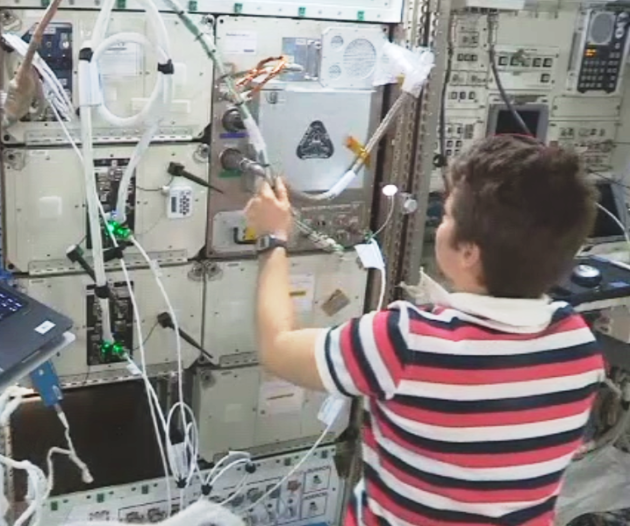
Astronaut Anne McClain installing the Tethers unlimited FDM 3D printer and recycling unit on board the ISS. She appears to be wearing a rugby shirt which would be fitting since she participated in the rugby world cup as well as being a helicopter pilot with 216 missions in Iraq, engineer, a mom and an aerospace engineer.
Tethers as a firm has always been a bit of a wild ride. The company started in 1994 looking to commercialize space tethers. Tethers in space are long (tensile) cables that can be tied to satellites and other space vehicles. Long dreamt about rarely used successfully the idea is that a long tether tied to a satellite could be used for propulsion or power generation in space. An Electrodynamic tether, for example, conducts and by passing through a planet’s magnetic field. This kind of tether can use the Lorentz force (electromagnetic force) of an electrified tether against the magnetic field of a planet to push the spacecraft into a new orbit. This would save on fuel and perhaps let craft slingshot around planets more efficiently. Momentum exchange tethers may actually let the spacecraft slingshot itself into space through spinning. A bolo of a tether tied to a craft may be used to spin and propel other craft onward in their journey.
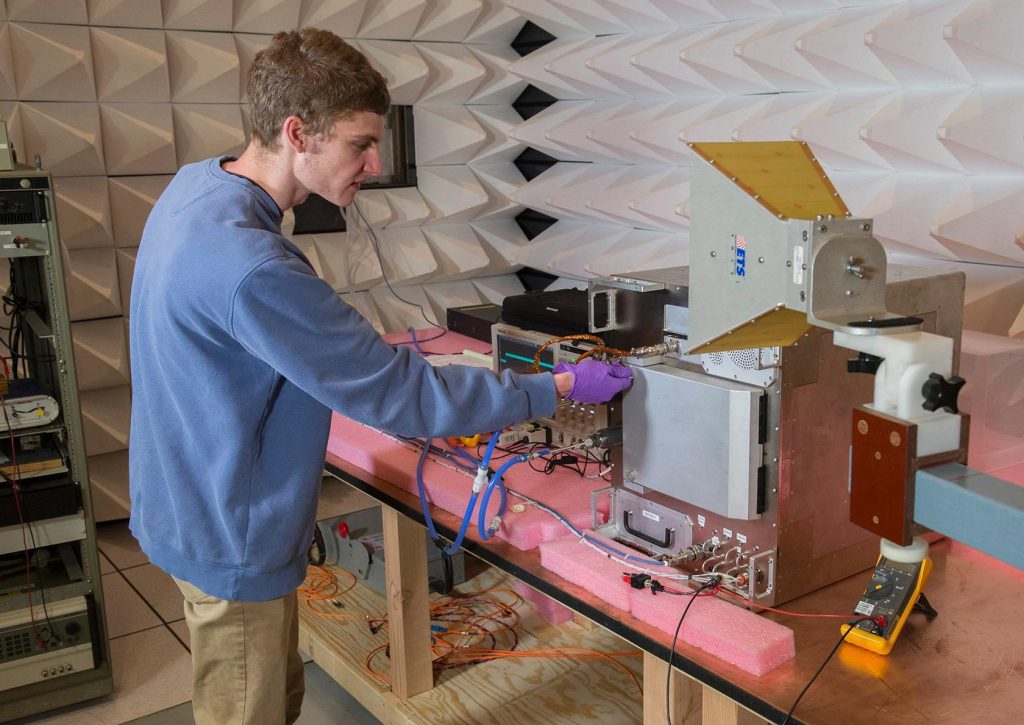
Marko Baricevic of Tethers Unlimited testing the Refabricator
Skyhooks would do the same but at much higher speeds. A space elevator is a tether tied to a craft in geosynchronous orbit above 35,000 KM in altitude which could be used to life payloads potentially inexpensively (once you build the most expensive thing ever which is also the biggest thing ever and also would need advances in material science to even be remotely feasible). Meanwhile, several 20 kilometer long tethers could together form an electric solar wind sail propelled by an electron gun shooting at these tethers to keep them in high potential while the craft spins giving the extended tethers centrifugal force and letting them stay extended enough for them to harvest force from solar wind plasma. Tethers could also be used to generate power. Tethers are amazing dream mayonnaise for making any insane space idea palatable. Tether dreams are way beyond Elon Musk’s comparatively quotidian dreams of cities of Mars and reusable rockets without Elon’s magical capital sourcing ability and media presence.

A momentum exchange tether courtesy of Tethers Unlimited
So for Tethers, the firm, going since 1994 a 3D printer and recycler onboard ISS may seem like a bit of a climb down and limited technical challenge compared to what they want to be doing. Nonetheless, for us, it is a great leap. If we conceive of astronauts spending many years in space and journeying through the solar system we know now that many unforeseen things will go wrong. Accidents will happen and valves not opening properly and nonfunctional O rings have killed astronauts. Just a few years ago a design flaw nearly caused an Italian astronaut to drown in space. If we extend our proposed space journeys to years then we know things we will not have foreseen will go wrong beyond any imaginary tolerance for failure that we can engineer away through redundancy. The perfect spacecraft may exist on the platform but it will not exist underway.
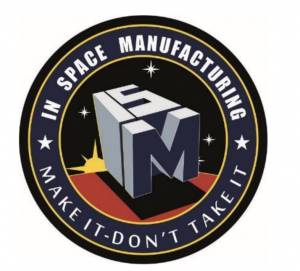
In essence, we need a magic satchel with stuff that could repair all the things in ways that we could not imagine them breaking. A combination of a 3D printer and a recycler is that magic satchel. A recycling unit can take food packaging, waste and things no longer need it and turn it into 3D printer filament which then can be printed into solutions for problems. Nonworking solutions can be recycled into iterations of better ones and all of those failures and the winner can be recycled into future solutions waiting to happen. We commonly refer to those as 3D printer filament. A spool of filament is really a seem of ideas not made yet or a roll of problems unsolved. The reason I love 3D printing and am completely obsessed with it is this idea of a recycler and 3D printer combo remaking our world forever letting us consumer while we reuse so please excuse the much more than efficient stream of words. NASA itself says that 95% of spare parts in space will never be used but they don’t know which 95% and that on the 13 tonne ISS they predict 450 Kilograms of failures each year. This in itself makes for a very compelling case for 3D printing spares.
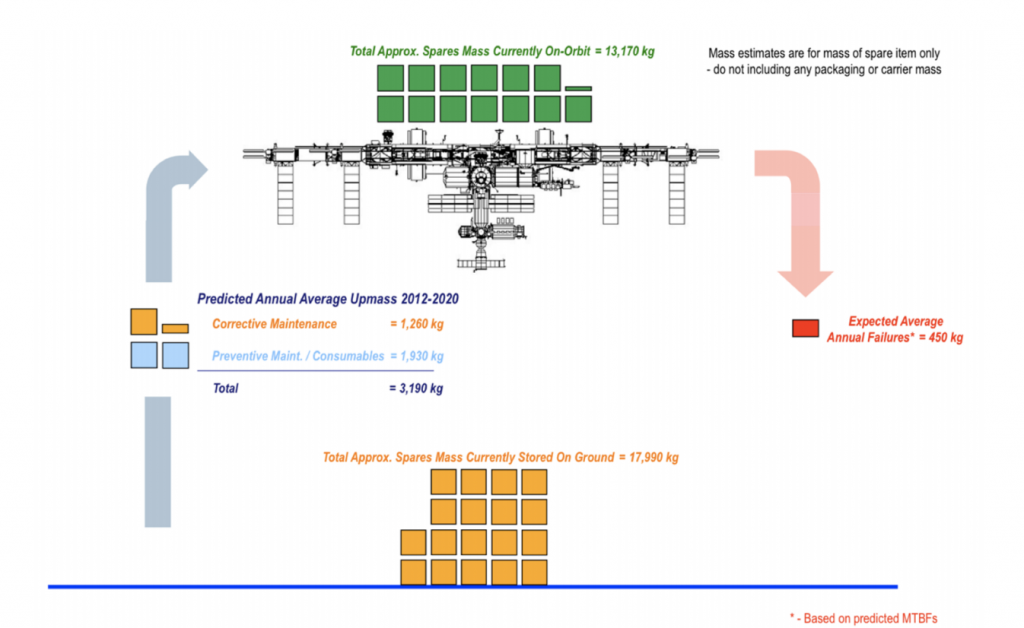
Graphical representation of ISS logistics.
Tethers has now made an Express rack compatible recycler that is being used on board the ISS as we speak. The Refabricators objective is to,
“The Refabricator demonstrates a unique process for repeatable, closed-loop recycling plastic materials for additive manufacturing in the microgravity environment of the ISS a minimum of seven times. Samples consisting of sections of filament and standardized material testing specimens are collected from each cycle in order to quantify any degradation of material that occurs during the recycling and printing process, and enhance the understanding of the recycling process in space.”
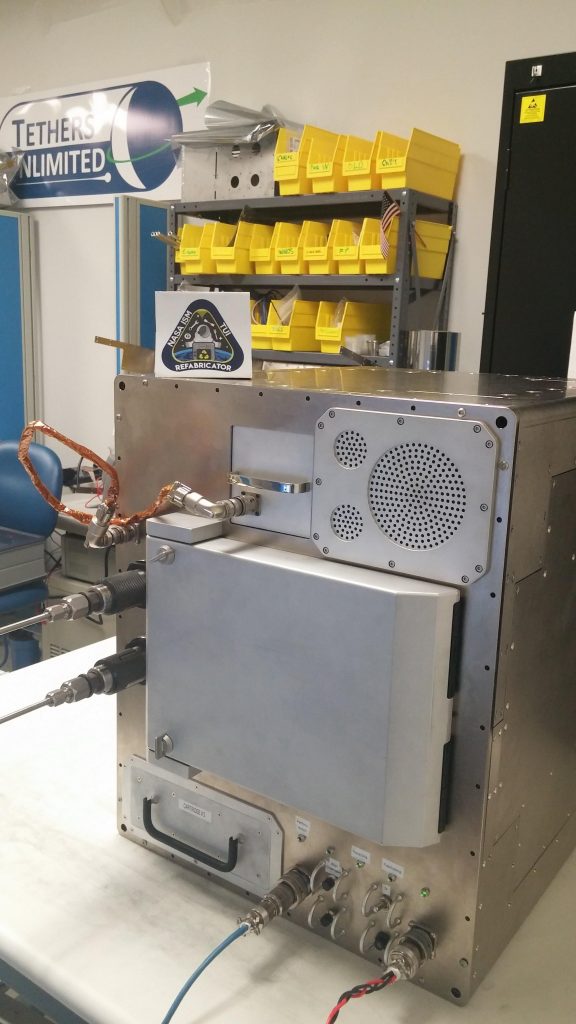
The Refabricator
This would be quite the polymer 3D printing challenge here on earth but at least NASA is being realistic on the number of recycling cycles and material degradation of plastics which a lot of people don’t seem to know. The Refabricator is meant to show,
“Integrated recycling/3D printing capability thus provides significant cost savings by reducing the launch mass and volume required for printer feedstock while decreasing Earth reliance.”
Tethers CEO Rob Hoyt said,
“It will provide future astronauts the ability to manufacture tools, replacement parts, utensils and medical implements when they need them, and greatly reduce the logistics costs for manned space missions by reusing waste materials and minimizing the amount of replacement parts that must be launched from Earth,”
The printer was made for $2.5 million so that’s a good amount to spend on engineering a printer that works well in space and can also recycle. Tethers has additional expertise via a $10 million FabLab project to make a fab lab in space but this is separate from Made In Space‘s own 3D printer initiative. Tethers Refabricator is meant to recycle ABS and they will do it through a process that they’ve called positrusion.
As well the Positrusion effort by Tethers NASA is also developing the CRISSP both as apart of NASA’s ISP (In Space Manufacturing) program. CRISSP is focused on recycling packaging but is also being carried out by Tethers while Cornerstone Research Group is doing a similar effort (but with creating reversible copolymers that can take antistatic bags and turn them into parts) and Resonetics has been tasked with making a sensor and monitoring package. Meanwhile Made in Space is working on its printer and 3D printed metal printing for NASA. Ultratech Machinery (with ultrasonic 3D printing), Techshot and Tethers again are also working on metal parts. With Tethers opting to use its Positrusion system for metals and then combine it with a robot arm and CNC. In metals Techshot wants to use low powered lasers with metal wire in its SIMPLE technology (which is far from it). Techshot’s SIMPLE will use an induction coil around an FDM nozzle to extrude a metal filament which is then sintered by a low power laser. Techshot itself is also working on recycling and separately biofabrication. whats better than astronauts? 3D printed astronauts. Weirdly GE isn’t apparently working for NASA on metal even though its EBM process has been evaluated thoroughly by NASA. Tethers is also working on medical printing in space while the Marshall Space Flight Center itself is trying to print electronics and circuits. NASA also has efforts underway to print structures in space outside of the vehicle which Made in Space, Loral, Orbital ATK and Tethers are working on. NASA also 3D printing structures on MARS so Elon has a place to live. This MARS effort has a contest element as well as a cooperation with the US Army Corps of Engineers here on earth with the ACES initiative which we’ve covered extensively. Additionally, NASA is printing engines and more parts for space systems themselves.
Positrusion is a new filament extrusion technology that Tethers came up with specifically for space based recycling. The system can accept “miscellaneous ABS parts, it will dry and degas the input material before melting and extruding it through a die, and the cross-sectional dimensions and feed-rate of the cooling extrudate will be tightly controlled in a continuous analog of closed-die molding.”
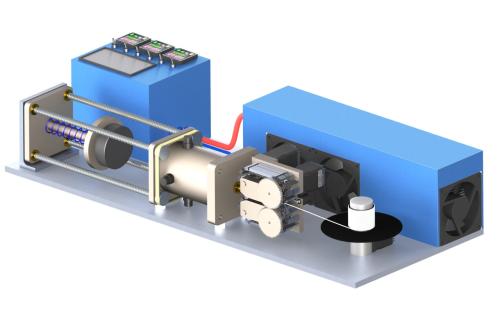
NASA diagram of the Positrusion recycling system
In closed die molding, material is injected into a closed cold mold at high velocity while degassing removes material and creates voids that must be filled while the build material is often quickly cooled. If the Refabricator can control the gas removal and make the filament free of voids while at the same time making sure that there is no bubbling on the surface then they could have a very small form factor recycling process. Tight control of that process could give them high-quality polymer parts as well. If they could tightly collapse the system they make have a really amazing nozzle based print head that can dose and deposit accurately at one point in the future.
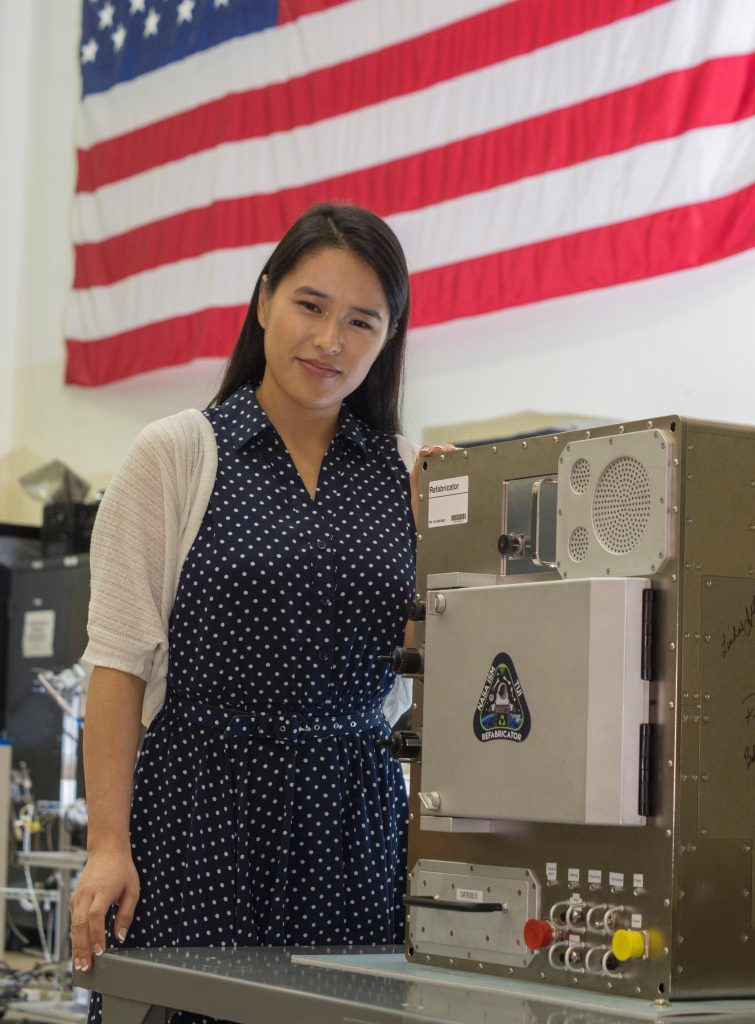
Dr. Allison Porter Missions Manager at Tethers Unlimited with the Refabricator
As well as ABS the system is being tested for use with Ultem 9085 this SABIC material is a UL 94-V0 rated low flame, toxicity and smoke high-performance polymer which you can here on earth get on your Stratasys system and is used widely in aerospace. For space use the Ultem would be significantly safer than ABS and a better bet going forward I should hope. Would this mean that NASA would be inclined to increase its use as build material across the space craft or in other material applications? Ultem Tang packaging anyone?
Developments as the Refabricator would seem to be absolutely essential for the future of space exploration and travel. By recycling what is on board and what is no longer used astronauts could develop solutions for many of the problems that they can encounter and extend the life of the craft that they are traveling on. Here on earth, refabricator-like devices could extend all of the things that surround us. What do you think will homes see refabricators or will this just be a tool for spacefarers? In the meantime here on Earth Tethers has just shed some very experienced people and is hoping to avoid another shutdown, a rather humdrum problem for a company that wishes to conquer the stars.
Summing up Additive Manufacturing in 2018
Find Prodways, Farsoon, Stratasys, Sabic and more 3D printing at Formnext 2018
 Formnext, the largest additive manufacturing and 3D printing trade show in Europe will take place in three weeks time from the 13th through to the 16th November 2018. In the lead up to one of the most highly anticipated shows of the year, 3D Printing Industry is collecting all of the latest product release teasers […]
Formnext, the largest additive manufacturing and 3D printing trade show in Europe will take place in three weeks time from the 13th through to the 16th November 2018. In the lead up to one of the most highly anticipated shows of the year, 3D Printing Industry is collecting all of the latest product release teasers […]2018 TCT Hall of Fame Inductees and 3D Printing Award Winners Announced
This year’s TCT Show, held in Birmingham as usual, ended earlier this week, and yielded many announcements about new 3D printing materials, software, and of course, 3D printers and their associated hardware. Additionally, the annual TCT Awards was held for the second time during a gala dinner at the Hilton Birmingham Metropole on Wednesday. British actor and presenter Robert Llewellyn hosted the nearly 300 guests at the awards, which celebrates, according to TCT Group owner Rapid News Publications Ltd, “the people, technology and collaborations behind the best in design-to-manufacturing innovation.”
There were 14 competitive award categories, and the TCT Awards recognized the partners in many collaborative projects, in addition to the designers, technology providers, and engineers. Three more 3D printing industry leaders were also inducted into the TCT Hall of Fame in honor of “their contribution to the industry and to the growth in technology adoption.”
“Once again it was a privilege to share an evening with so many truly exceptional people,” said Duncan Wood, Chief Executive of Rapid News. “All of the winners are to be congratulated for their successes, and of course in particular the Hall of Fame inductees need a special mention, their innovation, entrepreneurship and commitment has played a huge part in the development and success of the industry.
“I must also thank our sponsors 3ecruit, as well as our supporting partner, Innovate UK for their endorsement of the event and of course our judges. The TCT Awards night is fast becoming THE night of the year for the industry and we are looking forward to the 2019 edition already!”
The first of the new TCT Hall of Fame inductees is Dr. Carl Deckard, who invented and developed Selective Laser Sintering (SLS) 3D printing technology while based at the University of Texas. Together with his former professor Joe Beaman, Dr. Deckard co-founded DTM Corporation, which was later purchased by 3D Systems, to commercialize SLS 3D printing.
The second 2018 inductee into the TCT Hall of Fame is application specialist and process pioneer Greg Morris. In 1994 he founded Morris Technologies, a specialist AM services provider, which was purchased by GE Aviation in 2012, along with sister company Rapid Quality Manufacturing. His work in developing metal 3D printing applications and processes has increased their adoption in the aerospace and medical sectors, and he distributes his knowledge through his involvement in the speaking circuit.
Professor Emanuel ‘Ely’ Sachs, who invented binder jet printing at MIT in 1989, is this year’s final TCT Hall of Fame Inductee. Professor Sachs, who is on the leadership team of Desktop Metal and still teaches at MIT, actually coined the phrase ‘3D printing’ at that time, and binder jetting technology is a building block for much of the market’s current technology.
As for the rest of the TCT Awards, Project MELT, with its tech lead listed as BEEVERYCREATIVE, won this year’s Aerospace Application Award, while the winner of the Automotive Application Award was the BMW i8 roadster SLM bracket by tech lead SLM Solutions.
The Vitamix nozzle by Carbon won the Consumer Product Application Award, while the winner of the Creative Application Award was the Embrace jewelry collection by Cooksongold for Boltenstern. SPEE3D won the Hardware Award – Non Polymers for LightSPEE3D, and the Hardware Award – Polymers went to E3D for its Tool-Changer.
Axial3D won the Healthcare Application Award for the use of its pre-op planning model aids in a world-first surgery at Belfast City Hospital, and Trinckle 3D won the Industrial Product Application Award for its mass customization of copper inductors. The Materials Award – Non Polymer went to SABIC for its EXL AMHI240F 3D printing filament, and NanoSteel took the Materials Award – Polymers for its BLDRmetal L-40 steel 3D printing material.
3D Systems was the winner of the Metrology Award for its Aircraft Damage Assessment for Easyjet, and Steros GPA Innovate S.L. won the Post-Processing Award for its DLyte: Metal DryLyte Electropolishing. Materialise won the Software Award for its e-Stage Metal, and this year’s Rising Star Award was given to HiETA Technologies Ltd.
To learn more about the winning projects and companies, and see the Highly Commended projects, visit the TCT Awards website.
Discuss the TCT Awards and other 3D printing topics at 3DPrintBoard.com or share your thoughts in the comments below.


